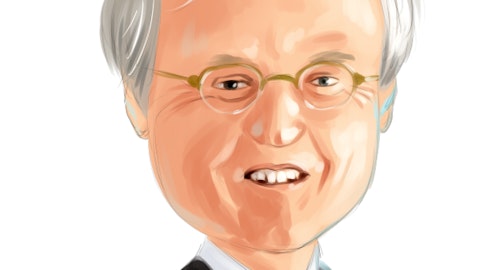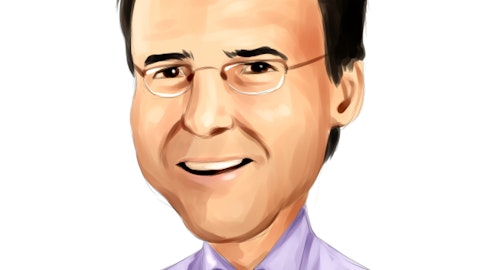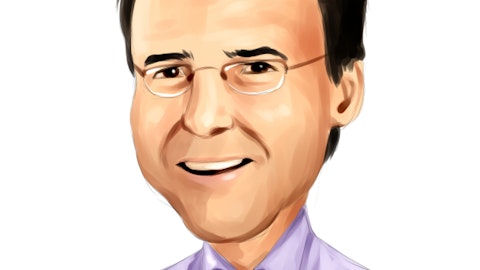Paul Reilly: Yes, the near-term NII guide factors in very modest loan growth, just given the environment still being pretty — in terms of the demand being pretty muted, particularly on the corporate side now. But we were pleased to see the growth during the quarter. And a lot of it was driven by securities-based loans and residential mortgages. And while we expect mortgage volume to decelerate, given much higher rates now, we are optimistic about the securities-based loan portfolio in both Raymond James Bank and TriState as we look forward over the next 12 months. And that’s based on two factors. The first is the repayments of those balances have really stabilized, as you would expect, accelerated significantly as rates were rising, almost doubling in some cases over the last 12 months.
And so, that has stabilized. And we are starting to see new origination. And on the TriState Capital side, a lot of benefit from what they call transitions, or essentially existing clients bringing on and recruiting new advisors. So, we are optimistic about that portfolio going forward over the next 12 months.
Paul Shoukry: I would just add, we are open for business, we have more than adequate cash and buffer, and certainly the capital, and it’s really just the loan demand. So, hopefully, the SBLs continue to go from being repaid to starting to grow, as we saw the indication last quarter. The mortgage business is obviously slow. And the commercial loans, we’re open to it. But it’s a very slow market. And spreads are widening for the deals that are coming out. But again, it’s more of a muted market. So, you saw this quarter, we’re open for business. We just have to find the loans that we’re comfortable with.
Benjamin Rubin: Great, that’s very helpful. And then, for my follow-up, I’ll kind of touch back on Dan’s first question about net new assets. So, net new asset growth in the quarter was 5%. It’s a bit below the high single-digit percentages you guys have been printing in recent years. I was just wondering if you can give me some color if there was any noise, any advisor departures that were lumpy that may have impacted the quarter, and whether or not this, let’s call it, mid-single-digit range is more appropriate. Or should we kind of — is it some revert back to the high single digits once the advisor market, if it does improve from here? Thank you.
Paul Shoukry: I think for the quarter, I mean, it’s been a dynamic year in a lot of ways, in terms of as you look at advisor count. I think that we had one program, which we previously talked about, that we exited from the platform. We kept 60% of the advisors, 40% left. And it cost us $4.6 billion in assets and 60 advisors. But we think from a profitability and long term, it was the right program. If you look just this month, again, adding a $3 billion bank program and 27 advisors just in one recruit, there are a lot of big projects like that. So, we’re still optimistic whether we get the double digits we had in a couple of quarters. It’s a big number, depending on the markets. But we expect to do very, very well. But that’ll be up to recruiting and what happens to the Capital Markets. So, I don’t know if you have anything to add, Paul.
Benjamin Rubin: Great, thanks for taking my questions.
Operator: Our next question comes from Steven Chubak with Wolfe Research. Your line is open.
Steven Chubak: Good afternoon, Paul and Paul.
Paul Reilly: Hey, Steve.
Paul Shoukry: Hey, Steve.
Steven Chubak: Hey. So, I wanted to start off with a question on spread revenue, came in better than your guidance in the quarter, it also trended better than what we saw at some of your peers and given you have a larger proportion of client cash that swept to third-party banks, to what extent is the spread revenue benefit from improved pricing from those partner banks provide any incremental boost. We know banks are seeking out alternative sources of liquidity. There’s a lot of demand for that whether you benefit from any improved pricing on some of those third-party sweeps?
Paul Reilly: I think our better performance than many peers is really just a reflection of our long-term focus on kind of maintaining a flexible approach that’s focused on giving clients as much FDIC insurance as possible. And you see that with the growth and enhanced savings program balances, which give us more flexibility in that dry powder that effectively puts more sweep balances with third-party banks as we await growth of the Bank’s balance sheet as Paul discussed earlier. And that in that dynamic, as you point out, Steve is absolutely correct. The banks, the demand from third-party banks is only increasing by the week and as contracts renew, we are able to renew at more favorable terms. So, that played a role, bigger picture of what really played a role was us just maintaining that sort of long-term flexible approach to managing the balance sheet and offering clients as much FDIC coverage as we possibly can to our various products.
Steven Chubak: It’s great. And for my follow-up, wanted to drill down into some of the October deposit trends, Paul that you would say that, given the sensitivity of spread revenue to changes in deposit mix, I was hoping you could provide some additional granularity disaggregating this sweep and ESP deposit levels and maybe help size the impact of the advisor payout?
Paul Reilly: When you say the advisor payout, are you referring to the quarterly fee billings or what have you…
Steven Chubak: Quarterly fee billings, which honestly, I care less about that, I really just was hoping to get the ESP and sweep deposit levels disaggregated given the sensitivity?
Paul Reilly: Got it. Yes, so we were down as a couple of days ago, $600 million, but this does bounce around from day-to-day. I mean, we had a $200 million positive day, yesterday, so at quarter-end we have $500 million. So, the balances are at numbers, we’re not used to high and low coming in and out. But the enhanced savings program is up probably $200 million to $300 million so far this month. And so, the net and the offset to that would obviously be the sweep balances, which frankly are doing much better than we would have expected given that we had the quarterly fee billings earlier this month as well. So, net-net cash to be down 500 to 600. When you add those two components, considering the $1.2 billion of quarterly fee billings, we’re pretty pleased with our situation right now. But again, it’s day to day can change today or tomorrow. So, we’re going to monitor it closely.
Steven Chubak: Sorry, go ahead.
Paul Reilly: Important thing for us, I mean just not on earnings, but the fact that we have so much money to third-party bank. So, we could use if we wanted to. And we really haven’t been borrowing. So, we have a lot of comfort to be able to go ahead and still have all the flexibility we need. But there has been the mix change with ESP with higher deposit costs. That’s what you’ve been seeing net-net.
Steven Chubak: Got it, that’s helpful color. Thanks for taking my questions.
Paul Reilly: Thanks, Steve.
Operator: Our next question comes from Mark McLaughlin with Bank of America. Your line is open.
Mark McLaughlin: Hi, thanks for taking my question. I was hoping you could provide us with some more color around deposit cost mix and specifically the pickup in money market and savings account yield?





